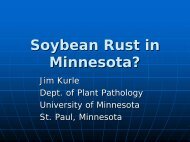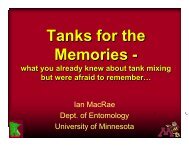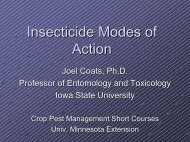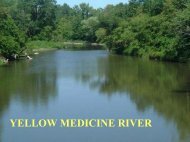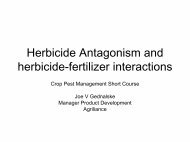Adjuvants: Principles and Use
Adjuvants: Principles and Use
Adjuvants: Principles and Use
Create successful ePaper yourself
Turn your PDF publications into a flip-book with our unique Google optimized e-Paper software.
ADJUVANTS: <strong>Principles</strong> <strong>and</strong> <strong>Use</strong>sDonald PennerMichigan State University
“What isanadjuvant?”
DefinitionsAdjuvant - A material added to a tank mix to aid or modify the action ofan agrichemical, or the physical characteristics of the mixture.ASTM, 1998Adjuvant - Any substance in a herbicide formulation or added to thespray tank to modify herbicidal activity or application characteristics.WSSA Herbicide H<strong>and</strong>book, 1994Adjuvant - Any agent used for wetting, spreading, deposit building,emulsifying, deflocculating, water modifying, or as a similar agent,with or without toxic properties of it’s own which is intended to beused with another pesticide, <strong>and</strong> sold in a package that is separatefrom that of the other pesticide.Calif. Food <strong>and</strong> Agricultural Code,Division 7, Chapter 2.
Current Interest in <strong>Adjuvants</strong>Spray modifiers:spreadersdrift controlActivator adjuvants: Crop Oil ConcentratesNonionic surfactantsWater conditioners
Classification of <strong>Adjuvants</strong>: ChargeChemical charge classes of surface active agents(surfactants)The active moiety contains both hydrophilic <strong>and</strong> lipophilicsegments• Anionic – negative charge• Cationic* - positive charge• Nonionic (NIS) – no charge• Ampholytic – both – <strong>and</strong> + charges* About 5600 tons applied to soybeans in the USA in 2002.
Classification of <strong>Adjuvants</strong>: ChemicalsNon-inclusive listing of activator adjuvant chemical classes1. Alkylaryl polyglycol ethers2. Alkyl phenol ethoxylates (APE)nonylphenol ethoxylates (NPE)3. Linear alcohol ethoxylates4. Alkyl glycosides5. Cationic tallow amines6. Phosphate esters7. Organosilicones8. Fatty acids- saponified- esterified: methyl or ethyl
Goals of Herbicide Applicator1. Satisfy the label.2. Decrease foaming in the tank.3. Decrease drift.4. Increase herbicide penetration into foliage.5. Increase spread of herbicide.6. Keep components of spray solution from settling orseparating.6. Need for conditioning hard water.
Goal:Maximize Herbicide PerformanceWith Activator <strong>Adjuvants</strong>1. Is the goal to keep the herbicide applicationrate constant <strong>and</strong> increase the spectrum ofweeds controlled?2. Or, is the goal to reduce the herbicideapplication rate but continue to control theweeds as well as before?
<strong>Adjuvants</strong> in the Spray Solution1. Included by manufacturer in theherbicide product.2. Adjuvant tank-mixed by applicator.
Registration of <strong>Adjuvants</strong>1. The USA does not have a national system for adjuvant registration.a) U.S. EPA regulates inerts, not adjuvants.b) Tolerance or tolerance exemption under 40 CFR 180.1001 for fooduse products.2. California has required registration of adjuvants for 30 years.a) 250 registered for crop protection use.b) They must be exempt from tolerance required under 40 CFR180.1001.c) California requires acute toxicity but no chronic or aquatic toxicology.d) Considerable physical-chemical data required.3. 5 other states register <strong>and</strong>/or review adjuvants but do not require all theinformation dem<strong>and</strong>ed by California.
Trends in Adjuvant <strong>Use</strong>Increase in pounds useda) Preemergence herbicide use postemergence herbicide useb) More information available on water conditionersc) Increase need to spray for soybean aphidsd) Increased interest in foliar feeding of plant nutrients
Question:Which adjuvant do I use with which herbicide?Answer:Read the label.“The adjuvant must be matched with theherbicide, the crop species, the weedspecies <strong>and</strong> the prevailing environment.”
For systemic pesticides:Activator adjuvants that increaseabsorptionFor contact pesticides:– Both spread <strong>and</strong> increased absorption areimportant– For contact insecticides <strong>and</strong> fungicides,consider spreader-stickers
Pairing Herbicides <strong>and</strong> <strong>Adjuvants</strong>(examples)Follow the labelCrop oil concentrate - Sulfonyurea <strong>and</strong> imidazolinoinesMethylated seed oils GraminicidesEthylated seed soilsSaponified seed oilsOrganosiliconesNonionic surfactantsWater conditionersnumerousglyphosate, diquat, numerousglyphosate, glufosinate
The Adjuvant B<strong>and</strong>wagon1990 – 2 organosilicone adjuvants showedpromise in research trials• Sylgard 390•SilwetL-772004 – 39 adjuvant products containorganosilicones
Herbicide absorption:• Preferred sites include:- basal cells of trichomes- the anticlinal walls of cells over veins- guard cells <strong>and</strong> anticlinal walls of accessory cells• Light increased absorption• Water stress decreased absorption• The cuticle, especially the wax, is the prime barrier tofoliar absorption of herbicides
Spray Droplet SpreadabilityAssumption: The greater the leaf areacovered by the spray droplet, the greaterthe herbicide absorption, <strong>and</strong> the greaterthe effectiveness of the herbicide.
Wetting agent properties <strong>and</strong> efficacy ofsilicone adjuvants with Na-acifluorfen 0.03kg/ha on velvetleaf_________________________________________________________________________________________________________________________________________SurfaceTreatment tension No rain Rain__________________________________________________________________________________________________________(dynes/cm) (% injury) (% injury)COC a (2.3 L/ha) - - 10 c 0 dDC-9 (1.2 L/ha) 21 60 a 41 bDC-14 (1.2 L/ha) 21 38 b 5 cd_________________________________________________________________________________________________________________________________________aCOC = Herbimax crop oil concentrate; DC-9 <strong>and</strong> DC-14 are Dow Corningexperimental adjuvants.
Effect of Roundup on velvetleaf (0.05 lb/A)<strong>and</strong> giant foxtail (0.20 lb/A) with severaladjuvants (0.25%)._______________________________________________________________________________________________________________Treatment Velvetleaf Giant foxtail Surface tension_______________________________________________________________________________________________________________(% injury) (% injury) (dynes/cm)Control 0 d 0 dRoundup 5 c 13 c+ X-77 3 cd 25 c+ DC 211 80 a 47 b < 23+ DC 212 33 b 70 a < 22
Basic AssumptionActivator adjuvants action involvesenhancing herbicide diffusionthrough the cuticle.
Velvetleaf adaxial leaf surfaces <strong>and</strong> Sylgard 309; effect of Sylgard 309 on 14 C-acifluorfen absorption, droplet spread, stomate density, <strong>and</strong> stomatacontacted per droplet.Leaf 14-C acifluorfen Spread of Stomate StomataPosition absorption 2-ul droplet density contacted _% in 1 min cm 2 no. per mm 2 no. per dropletCotyledon 86 0.95 63 5985Leaf 1 80 1.92 90 17280Leaf 2 77 2.86 109 31174Leaf 3 55 3.88 131 50828Leaf 4 43 4.16 125 52000Leaf 5 48 4.15 156 64740Leaf 6 15 4.98 134 66732Leaf 7 9 5.34 172 91848___ LSD 0.05 _____ _ 7.8__ __ __ 0.73____ __ 44__________
ConclusionMythStomatal floodingStomatal infiltration
Glyphosate Productsglyphosate acid- counter ion+ surfactant blend solventa.e.a.i.product
Adjuvant Load in Glyphosate ProductsI. None ex. RODEO, ACCORD, Clearout 41II.III.Partial load ex. Original ROUNDUP,TOUCHDOWN IQ, GLYPHOSFull load ex. ROUNDUP ULTRAMAX,WEATHERMAX.
Popular surfactants included inglyphosate products• Tallowamine ethoxylates• Phosphate esters• Alkyl polyglycosides
Glyphosate AcidO Ol l l lHO -C -CH 2 - NH - CH 2 -P -O-H +lOHGlyphosate Isopropylamine SaltGlyphosate Ammonium SaltO Ol ll lHO -C-CH 2 - NH - CH 2 -P-O- +NH 4lOHO O CH 3l l l l lHO -C-CH 2 - NH - CH 2 -P-O-H 3 N + -CHllOH CH 3Glyphosate Trimethylsulfonium SaltO O CH 3l ll l lHO -C-CH 2 - NH - CH 2 -P-O- +S - CH 3l lOH CH 3Glyphosate Potassium SaltOOllllHO – C - CH 2 –NH-CH 2 –P–O - -K +lOH
Does the counterion in glyphosate saltsaffect herbicidal activity?Glyphosate – IPAdoes not injure Roundup-ReadycornGlyphosate –TMSinjures Roundup-Ready corn
Comparison of three rates of three formulations ofglyphosate without additional adjuvants applied in tapwater 14 DAT.VELVETLEAFHerbicide rateRoundup Touchdown TouchdownUltramax IQ V(lb ae/A)-----------------------(%control)--------------------0.25 42 56 610.375 84 61 730.56 87 74 88LSD 0.05 = 8PRICKLY SIDA0.25 43 60 630.375 70 56 650.56 81 68 80LSD 0.05 = 6Penner & Michael 2001 NCWSS
“Water Conditioning”<strong>Adjuvants</strong><strong>Use</strong>ful for weakly acidic postemergenceherbicides applied in hard water.
History of Water Conditioning<strong>Adjuvants</strong>Mid-1970’s Evaluated fertilizer – herbicide combinationsDiammonium sulfate28% UANUreaAmmonium nitrate10-34-0Mid-1990’s Established mechanism of action basis forammonium sulfate – glyphosate interaction using NMRNH 4+glyphosate - outcompeting Ca ++ ,Mg ++ , Fe +++SO 4-Ca ++ Ca SO 4Term “water conditioning adjuvant” comes into usage.
Role of ammoniumWith AmmoniumNH 4+NH+4+Glyphosate -NH 4+NH 4+NH 4 - glyphosateNH 4+(Readily absorbed)
Additional Considerations:- Disassociation may occur in solution for salts of weakacid herbicides.Glyphosate - IPA (Garbow et al., 1995).-Ca ++ in hard water may replace the IPA associatedwith glyphosate - IPA (Thelen et al., 1995).- The cation exchange for Ca ++ by glyphosate - IPA is afunction of the ratio of glyphosate - IPA to Ca ++ .- Ammonium sulfate in the spray solution can “flood”the system with NH 4+ ions overcoming the formationof glyphosate - Ca ++ (Thelen et al., 1995).
Ammonium SourcesDiammonium sulfate – dry, liquidAmmonium nitrate – liquid, ½ of 28% UANDiammonium phosphate –dryApplicators prefer to pour or pump liquids notweigh adjuvants. Addition of dry material cantemporarily plug the spray system.
Water Hardness• grains/gallon• ppm• 15 grains/gallon = 250 ppm CaCO 3• ppm Ca ++ x 2.49 = ppm CaCO 3
Total water hardness (as CaCO 3 )Grains/gal: 0 1.5 3 7 15 25ppm: 0 25 50 120 250 450Soft……..Hard……..Very Hardppm Ca ++ x 2.9 = ppm CaCO 3
Hard Water ProblemsOOH O-C-CH 2 -NH-CH 2 -O–O - Ca ++OHFe ++Fe ++Mg ++
HARD WATER ION EFFECTS ON GLYPHOSATE% GROWTH REDUCTION OF OATS AT 0.35 LB / ACRE100806040200None Mg++ Fe++ HCO3++ Ca++ Fe+++5 mM Salt Concentration
Hall et al. 2000. Pest Manag.Sci. 50: 351 - 358 observed thatthe efficiency of NH 4+ inincreasing glyphosate activity onvelvetleaf was related to thecalcium in <strong>and</strong> on the leaves.Calcium levels were 3 timeshigher in leaves of velvetleaf thanjohnsongrass.
Efficacy of adjuvants on several glyphosate formulationsevaluated 14 DAT on three weed species in greenhousetrialsGIANT a COMMON b VELVET- aTreatment FOXTAIL LAMBSQUARTERS LEAF(% Control)Glyphosate Acid 16 2 0Glyphosate Acid + AMS c 55 0 57Glyphosate Acid + RI d 28 75 1Glyphosate Acid + RI + AMS 70 64 76GF e 48 49 10GF + AMS 79 64 74GF + RI 53 78 8GF + RI + AMS 79 83 77RU f 39 95 9RU + AMS 79 86 75LSD (0.05) 15 16 10aGlyphosate applied at 0.28 kg ae/habGlyphosate applied at 0.45 kg ae/hacAMS applied at 1% w/v (8.5 lbs/100 gal water)dRI, Reddy It, a product of <strong>Adjuvants</strong> Plus, applied at 0.3% v/veGF, Glyfos ® , a product of CheminovafRU, Roundup UltraMax®, a product of MonsantoPenner et al. ASTM STP1449. p158. 2003.
ROUNDUPWEATHERMAX0.30 lb ae / A+ 2% AMSROUNDUPWEATHERMAX0.30 lb ae / ACHECK
EFFECT of AMS on PERFORMANCE of GLYPHOSATEVENICE MALLOW in the GREENHOUSE - 10 DATCONTROLROUNDUPWEATHERMAX0.15 lb ae / AROUNDUPWEATHERMAX0.15 lb ae / A+ 2 % AMSROUNDUPWEATHERMAX0.30 lb ae / AROUNDUPWEATHERMAX0.30 lb ae / A+ 2 % AMS
CONTROLCLEAROUT41+ 2.5% CLASSACT NG+ 2% AMS
The enhancement of glyphosate efficacywith (NH 4 ) 2 SO 4 is weed species dependent.Velvetleaf > Giant foxtail > Common lambsquarters
GlyphosatealoneGlyphosate+ 2 % AMSGlyphosate+ 500 ppmCalciumGlyphosate+ 2 % AMS+ 500 ppmCalciumGlyphosatealone Glyphosate+ 2 % AMSGlyphosate+ 500 ppmGlyphosateCalcium+ 2 % AMS+ 500 ppmCalciumGlyphosate+ 500 ppm GlyphosateManganese +2 % AMS+ 500 ppmManganeseGlyphosatealoneGlyphosate+ 2 % AMSGlyphosate+ 500 ppmCalciumGlyphosate+ 2 % AMS+ 500 ppmCalciumGlyphosate+ 500 ppmIronGlyphosate+ 2 % AMS+ 500 ppmIronGlyphosatealoneGlyphosate+ 2 % AMSGlyphosate+ 500 ppmCalciumGlyphosate+ 2 % AMS+ 500 ppmCalciumGlyphosate+ 500 ppmMagnesiumGlyphosate+ 2 % AMS+ 500 ppmMagnesium
ControlRW +(NH 4) 2SO 4RW aRW +Exacto 390RW +NH 4NO 3bRW +RW +NH 4OH b RW +NH 4NOc3H 2SOd4
Summary for Water Conditioners1. Unless you have soft water or only common lambsquartersuse a water conditioner.2. Not all water conditioners are alike or effective.Diammonium sulfate is the st<strong>and</strong>ardOther effective ones include:Class Act Next Generation (other liquid (NH 4) 2SO 4products)NTANKNTENSE
ConclusionHypothesis ! Theory ! Dictum“<strong>Adjuvants</strong> must be matched to aparticular herbicide, weed spectrum,<strong>and</strong> environment to ensure that theyenhance, <strong>and</strong> not detract from,postemergence herbicide efficacy.”
Current <strong>and</strong> Future ChallengesSelection of the most effective adjuvants for:1. Postemergence herbicides combinations2. Pre- <strong>and</strong> postemergence herbicides combinations3. Herbicide-insecticide combinations4. Herbicide <strong>and</strong> plant nutrient combinations



